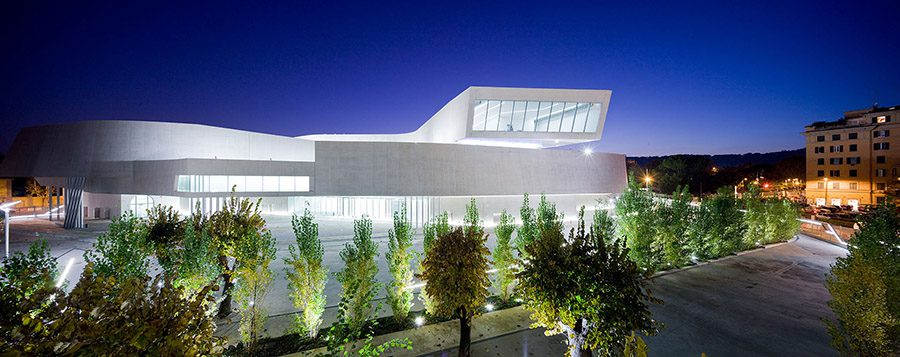ARCHITECTURE:MAXXI Museum
 MAXXI, the first Italian public museum devoted to contemporary creativity, arts and architecture provides not only a space in which to exhibit art, but a research space where contemporary languages of design, fashion, cinema, art and architecture can meet in new dialogue. Three words encapsulate the MAXXI vision, innovation, multiculturalism, interdisciplinary.
MAXXI, the first Italian public museum devoted to contemporary creativity, arts and architecture provides not only a space in which to exhibit art, but a research space where contemporary languages of design, fashion, cinema, art and architecture can meet in new dialogue. Three words encapsulate the MAXXI vision, innovation, multiculturalism, interdisciplinary.
By Efi Michalarou
The MAXXI Museum is located in the Flaminio quarter of Rome, in the area of the former Montello military barracks. The complex houses two institutions: MAXXI Arte and MAXXI Architecture, aiming to promote art and architecture through collection, conservation, study and exhibition of contemporary works. The design of Zaha Hadid was the winner of an international design competition, chosen from among 273 candidates.. The competition proposal by Zaha Hadid envisaged the construction of five new structures, only one of which has been actually built. Designed as a true multi-disciplinary and multi-purpose campus of the arts and culture, the MAXXI creates an urban complex for the city that can be enjoyed by all. In addition to the two museums the MAXXI includes an auditorium, library and media library, bookshop and cafeteria, spaces for temporary exhibitions, outdoor spaces, live events and commercial activities, laboratories, and places for study and leisure. The two museums: MAXXI Art and MAXXI Architecture, are located around a large full height space which gives access to the galleries dedicated to permanent collections and temporary exhibitions, the auditorium, reception services, cafeteria and bookshop. Outside, a pedestrian walkway follows the outline of the building, restoring an urban link that has been blocked for almost a century by the former military barracks. The interior spaces, defined by the exhibition walls, are covered by a glass roof that flood the galleries with natural light filtered by the louvered lines of the roofing beams. These beams underline the linearity of the spatial system, aid in articulating the various orientations of the galleries and facilitate circulation through the museum and campus. As Zaha HAdis said “The MAXXI should not be considered just one building – but several. The idea was to move away from the idea of “the museum as an object” and towards the idea of a “field of buildings”. After many studies, our research evolved into the concept of the confluence of lines, where the primary force of the site is the walls that constantly intersect and separate to create both indoor and outdoor spaces. It’s no longer just a museum, but an urban cultural centre where a dense texture of interior and exterior spaces have been intertwined and superimposed over one another. It’s an intriguing mixture of galleries, irrigating a large urban field with linear display surfaces. The walls of the MAXXI create major streams and minor streams. The major streams are the galleries, and the minor streams are the connections and the bridges. The site has a unique L-shaped footprint that meanders between two existing buildings. Rather than seeing this as a limitation, we used it to our advantage, taking it as an opportunity to explore the possibilities of linear structure by bundling, twisting, and building mass in some areas and reducing it in others – threading linearity throughout both interior and exterior or the MAXXI.”
